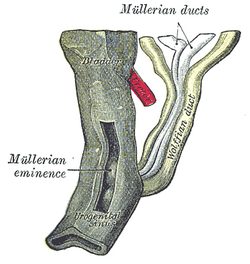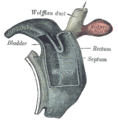|
Mesonephric duct
The mesonephric duct, also known as the Wolffian duct, archinephric duct, Leydig's duct or nephric duct, is a paired organ that develops in the early stages of embryonic development in humans and other mammals. It is an important structure that plays a critical role in the formation of male reproductive organs. The duct is named after Caspar Friedrich Wolff, a German physiologist and embryologist who first described it in 1759.[1] During embryonic development, the mesonephric ducts form as a part of the urogenital system.[2] StructureThe mesonephric duct connects the primitive kidney, the mesonephros, to the cloaca. It also serves as the primordium for male urogenital structures including the epididymides, vasa deferentia, and seminal vesicles. DevelopmentIn both males and females, the mesonephric ducts develop into the trigone of urinary bladder, a part of the bladder wall, but the sexes differentiate in other ways during development of the urinary and reproductive organs. MaleIn a male, they develop into a system of connected organs between the efferent ducts of the testis and the prostate, namely the epididymis, the vas deferens, and the seminal vesicle. The prostate forms from the urogenital sinus and the efferent ducts form from the mesonephric tubules. For this, it is critical that the ducts are exposed to testosterone during embryogenesis. Testosterone binds to and activates androgen receptor, affecting intracellular signals and modifying the expression of numerous genes.[3] In the mature male, the function of this system is to store and mature sperm, and provide accessory semen fluid.The mesonephric duct (precursor of the male reproductive system) forms around the 3-4th week of pregnancy, present before the paramesonephric duct (precursor of the female reproductive system). FemaleIn the female, with the absence of anti-Müllerian hormone secretion by the Sertoli cells and subsequent Müllerian apoptosis, the mesonephric ducts regress, although inclusions may persist. The vestigial epoophoron arises from these ducts. Also, lateral to the wall of the vagina, a Gartner's duct could develop as a remnant. FunctionSexual differentiationHistoryIt is named after Caspar Friedrich Wolff who described the mesonephros and its ducts in his dissertation in 1759.[1] Additional images
See also
References
External linksInformation related to Mesonephric duct |
||||||||||||||||||||||||





